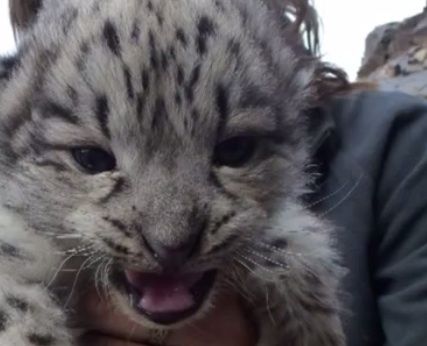
Snow Leopard's Fate Hinges on Historic Talks (Op-Ed)

Bradnee Chambers, Executive Secretary of the United Nations Environment Program Convention on the Conservation of Migratory Species of Wild Animals, contributed this article to LiveScience's Expert Voices: Op-Ed & Insights.
Snow leopards are struggling to survive in their mountain habitats — driven to the brink of extinction by increasing intrusions into their rocky domain and by the insatiable demand for their fur and bones. But, the Global Snow Leopard Conservation Forum in the Kyrgyz capital, Bishkek, in October can reverse this trend.
Snow leopards often travel huge distances along ridge lines and cliff bases, but increasing threats from a growing human footprint are dissecting their habitat, putting the survival of these animals at risk.
Expanding human populations and the demand for more and more land for agriculture and livestock herding are encroaching on snow leopard ranges, even into protected areas. As leopards are forced into living in closer proximity to humans, conflicts with shepherds are almost inevitable.
Because of overhunting and poaching of their favorite prey, the endangered Argali sheep, the leopards are turning to domestic animals — goats and sheep — instead. This leads to retributive killing of snow leopards by angry herders. Feral dogs hunt livestock as well, but since the snow leopard is a protected species, farmers blame snow leopards for attacking livestock because they will be reimbursed.
Also contributing to the snow leopard's downfall is its splendid coat, essential for the animal to survive the bitter cold of the Himalayas, the Hindu Kush, the Pamirs and the Altai Mountains of Central Asia — at altitudes as high as 5 kilometers (3 miles). The species is classified as endangered , according to the International Union for Conservation of Nature (IUCN)'s Red List.
Despite the highest level of protection under the Convention on International Trade in Endangered Species (CITES), a lucrative illegal trade flourishes as leopards are killed for their skin and bones, meeting the demands of both the fur industry and traditional Chinese medicine.
Sign up for the Live Science daily newsletter now
Get the world’s most fascinating discoveries delivered straight to your inbox.
In today's market, a top-quality garment made of leopard skin — made up of between six and twelve animals — could command a price as high as $60,000 in affluent global markets. It is not, however, the local hunters who are benefiting from this unsustainable trade — their share of the profit is unlikely to be much more than $100 per skin, and frequently considerably less. But in these remote, underdeveloped and poverty-stricken regions, even $50 is a considerable sum.
Estimates suggest that there are between 3,500 and 7,000 snow leopards left in the wild, from Afghanistan in the west, China to the east, Russia to the north and Myanmar to the south. However, the breeding population is probably little more than 2,500 animals distributed over an area of more than 1 million square kilometers (386,102 square miles).
But the upcoming Global Snow Leopard Conservation Forum in the Kyrgyz Republic might change the course of the snow leopard's fate.
In promoting the conservation of the snow leopard, Kyrgyz's President Almazbek Atambayev is playing a similar role to the one played by Russian President Vladimir Putin at the Global Tiger Summit in St. Petersburg, Russia, in November 2010. [Surprising Ally For Snow Leopards: Buddhist Monks ]
At St. Petersburg, a cast of celebrity supporters such as Leonardo di Caprio, as well as donor nations and conservation nongovernmental organizations, were in attendance. About $500 million was pledged, repledged or repackaged (vague promises made more concrete, or existing funds diverted into new efforts). The contributions, over five years, will to try to double the number of tigers living in the wild. Despite countries making encouraging noises, half of them had failed to meet their obligations to protect tigers under CITES. With the cameras gone and the adrenaline rush subsided, will the enthusiasm remain to turn the fine words into effective deeds? Time will tell.
The snow leopard — one of the tiger's smaller, more elusive and enigmatic cousins, is in a similar predicament.

Kyrgyzstan has already hosted a preparatory meeting with support of the World Bank Global Tiger Initiative. Two additional meetings followed in Bangkok in March and in Moscow in May, attended by representatives of CITES, the wildlife trade-monitoring network TRAFFIC, USAID and the Convention on Migratory Species (CMS).
The meetings provided an opportunity for countries to present the "zero drafts" of their National Snow Leopard Ecosystem Protection Priorities, which are the initial building blocks for the proposed Global Snow Leopard Protection Program.
CMS is well-represented in the region — of the 12 snow leopard range states, six are parties to CMS, four more participate in regional CMS conservation instruments and one of the remaining two is reportedly close to joining to the convention. The snow leopard has been inscribed on the CMS Appendix I since 1985, requiring parties to accord the species the highest level of protection.
CMS has a long track record of engagement in Central Asia — the first CMS agreement between governments concluded more than 20 years ago — and covers species such as the Siberian crane, along with recent additions of the Saiga antelope, the Bukhara deer and the Argali sheep.
There are many forums dealing with the conservation of endangered species. We cannot afford fruitless attempts to conserve this magnificent big cat when heads of state meet in October. It would be best if those leaders all collaborated and pooled their strengths to ensure fully coordinated conservation efforts. The World Bank's resources and the Convention on Migratory Species' expertise and experience in the region could be the winning combination that the snow leopard so desperately needs.
The views expressed are those of the author and do not necessarily reflect the views of the publisher. This version of the article was originally published on LiveScience.











